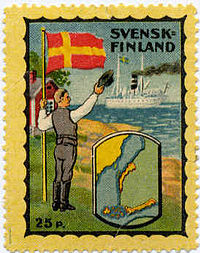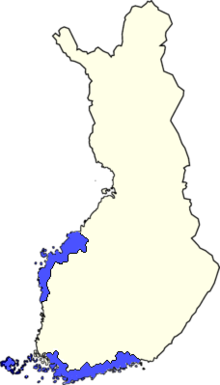
The Baltic Sea is an arm of the Atlantic Ocean that is enclosed by Denmark, Estonia, Finland, Germany, Latvia, Lithuania, Poland, Russia, Sweden, and the North and Central European Plain.

Vantaa is a city in Finland. It is located to the north of the capital, Helsinki, in southern Uusimaa. The population of Vantaa is approximately 247,000. It is the 4th most populous municipality in Finland. Vantaa is part of the Helsinki Metropolitan Area, which has approximately 1.58 million inhabitants.
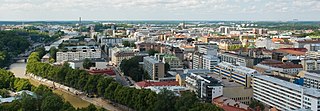
Turku is a city in Finland and the regional capital of Southwest Finland. It is located on the southwestern coast of the country at the mouth of the River Aura. The population of Turku is approximately 202,000, while the metropolitan area has a population of approximately 311,000. It is the 6th most populous municipality in Finland, and the third most populous urban area in the country after Helsinki and Tampere.

Kokkola is a town in Finland and the regional capital of Central Ostrobothnia. It is located on the west coast of the country, on the Gulf of Bothnia. The population of Kokkola is approximately 48,000, while the sub-region has a population of approximately 54,000. It is the 22nd most populous municipality in Finland, and the 20th most populous urban area in the country.

The Swedish-speaking population of Finland is a linguistic minority in Finland. They maintain a strong identity and are seen either as a separate cultural or linguistic group or, while not regularly, as a distinct nationality. They speak Finland Swedish, which encompasses both a standard language and distinct dialects that are mutually intelligible with the dialects spoken in Sweden and, to a lesser extent, other Scandinavian languages.
The Swedish People's Party of Finland is a Finnish political party founded in 1906. Its primary aim is to represent the interests of the minority Swedish-speaking population of Finland. The party is currently a participant in the Government of Petteri Orpo, holding the posts of Minister of Education, Minister for European Affairs, and Minister of Youth, Sport and Physical Activity.

Åbo Akademi University is the only exclusively Swedish language multi-faculty university in Finland. It is located mainly in Turku but has also activities in Vaasa. Åbo Akademi should not be confused with the Royal Academy of Åbo, which was founded in 1640, but moved to Helsinki after the Turku fire of 1827 and is today known as the University of Helsinki.

Alahärmä is a former municipality of Finland. It was consolidated, together with Kortesjärvi and Ylihärmä, to Kauhava on 1 January 2009.

The Finnish War was fought between the Kingdom of Sweden and the Russian Empire from 21 February 1808 to 17 September 1809 as part of the Napoleonic Wars. As a result of the war, the eastern third of Sweden was established as the autonomous Grand Duchy of Finland, a state under the rule of the Russian Empire. Other notable effects were the Swedish parliament's adoption of a new constitution and the establishment of the House of Bernadotte, the new Swedish royal house, in 1818.

Kotka is a town in Finland, located on the southeastern coast of the country at the mouth of the Kymi River. The population of Kotka is approximately 51,000, while the sub-region has a population of approximately 80,000. It is the 21st most populous municipality in Finland, and the 16th most populous urban area in the country.

Southwest Finland, calqued as Finland Proper, is a region in the southwest of Finland. It borders the regions of Satakunta, Pirkanmaa, Tavastia Proper (Kanta-Häme), Uusimaa, and Åland. The region's capital and most populous city is Turku, which was the capital city of Finland before Helsinki.

Karelia is an area in Northern Europe of historical significance for Russia, Finland, and Sweden. It is currently divided between northwestern Russia and Finland.

Korsnäs is a municipality in Finland, located on the west coast of the country. Korsnäs is situated in Ostrobothnia, along the Gulf of Bothnia. The population of Korsnäs is approximately 2,000, while the sub-region has a population of approximately 110,000. It is the 258th most populous municipality in Finland.

Korsholm is a municipality in Finland, located on the west coast of the country. Korsholm is situated in Ostrobothnia, along the Gulf of Bothnia. The population of Korsholm is approximately 20,000, while the sub-region has a population of approximately 110,000. It is the 55th most populous municipality in Finland.

Ruotsinpyhtää is a former municipality of Finland. Ruotsinpyhtää, Pernå and Liljendal were consolidated to Loviisa on January 1, 2010.
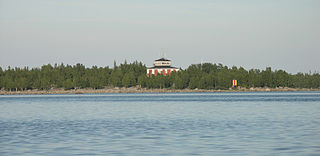
Vörå is a municipality in Finland, located on the west coast of the country. Vörå is situated in Ostrobothnia, along the Gulf of Bothnia. The population of Vörå is approximately 6,000, while the sub-region has a population of approximately 110,000. It is the 149th most populous municipality in Finland.

The Archipelago Sea is a part of the Baltic Sea between the Gulf of Bothnia, the Gulf of Finland and the Sea of Åland, within Finnish territorial waters. By some definitions it contains the largest archipelago in the world by the number of islands, although many of the islands are very small and tightly clustered.

The flag of the Swedish-speaking Finns is an unofficial red flag with a yellow cross used in the Swedish-speaking parts of Finland to represent the Finland-Swedes. It may be flown in addition to the Finnish blue and white flag. This flag is unfamiliar to many in Finland but there have been attempts to introduce it again to a broader audience as what is known as "household pennants" demonstrating one's identity as Swedish-speaking, are more common and can be seen on many flagpoles in areas where there live many Swedish-speaking Finns, especially in countryside.
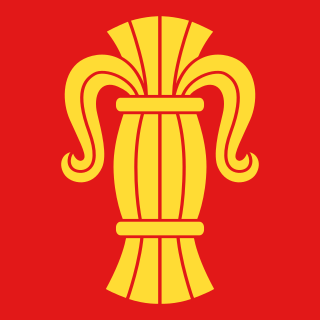
Vaasa, in the years 1855–1917 as Nikolainkaupunki, is a city in Finland and the regional capital of Ostrobothnia. It is located on the west coast of the country, on the Gulf of Bothnia. The population of Vaasa is approximately 69,000, while the sub-region has a population of approximately 110,000. It is the 14th most populous municipality in Finland, and the tenth most populous urban area in the country.
Svenska Kvinnoförbundet is the women's wing of the Swedish People's Party of Finland. The federation was founded in 1907 and has around 2,500 members. The federation consists of 28 local organisations throughout the Swedish-speaking areas of Finland, traditionally known as Svenskfinland.
